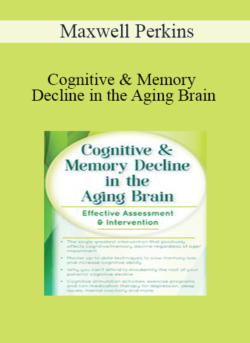13 Hours 20 MinutesYou NEED to understand cardiac and neurologic anatomy and physiology — even the most seasoned nurses are overwhelmed with the complexities of these body systems. The key to avoiding life–threatening complications is to identify subtle changes in your patient’s symptoms early.Purchase Recognizing Early Signs of Trouble: Cardiac & Neuro Emergencies -Sean G. Smith & Tom F. Gutchewsky courses at here with PRICE $199.99 $85Heart Disease and Stroke are the two leading causes of death in the world…You NEED to understand cardiac and neurologic anatomy and physiology — even the most seasoned nurses are overwhelmed with the complexities of these body systems. The key to avoiding life–threatening complications is to identify subtle changes in your patient’s symptoms early.Now in this comprehensive online course, two hand–picked experts with 40+ years of combined experience give you the tools you need to identify presenting and evolving symptoms so you can confidently intervene before a situation becomes life–threatening.Walk away with clinical pearls like:Most recent pharmacological treatments available for cardiac and neuro emergenciesKey insights to anticipate when an invasive procedure like angioplasty, stenting or surgery is likelyHow patients with asymptomatic VPBs in the peri–infarct period, when given antiarrhythmic drugs, can have an increased risk for mortalityWhich therapeutic treatment will yield the best results based on current ICPThe latest evidence–based strategies for neuro traumaAnd so much more!Here’s what you will learn in this comprehensive online course:Acute Cardiac Conditions: Quick Assessment & Rapid ActionModule 1: Acute Cardiac PathologyReview angiogram films to identify specific pathology including culprit vs. chronic lesionsIdentify changes of acute MV regurgitation caused by myocardial ischemia on echocardiogramObserve how an intra-aortic balloon pump can stabilize a patient with ventral septal defect caused by MI prior to surgeryDiscuss which drugs are most beneficial for specific conditions and adhere to AHA recommendationsModule 2: Aortic DissectionStanford types A and B – including common causes, which patients are at risk, and typical presenting symptomsReview diagnostic techniques and images including echocardiogram, TEE, and CT scans for pathological findingsWhich patients require emergency surgery vs. medical management?Explore the latest surgical techniques used in treatmentModule 3: Cardiac TamponadeIdentify the symptoms of cardiac tamponade including the components of Beck’s triadLearn the causes of pericardial tamponadeReview diagnostic echocardiogram and CT imagesAppropriate treatments including pericardiocentesis and pericardial window surgical proceduresModule 4: Cardiogenic ShockUnderstand the multiple causes of cardiogenic shock to identify early symptomsCompare the function of diagnostic techniques, including echocardiogram and swanganz cathetersGain insight into typical and more advanced treatments including fluid resuscitation, medication, interventions, intra-aortic balloon pumps, ECMO, and VADsModule 5: Cardiac ArrhythmiasIdentify acute cardiac arrhythmias including atrial fibrillation/flutter, 3rd-degree heart block and ventricular tachycardia by EKG findingsReview common etiologies and risk factorsExplore treatment options including medication, electricity, and ablation proceduresThe Complex Neuro Patient: Strategies to Take Your Practice to the Next LevelModule 1: NeuroanatomySummarize neuroanatomy as applicable to complex neurological patientsOverview of the nervous system: Central Nervous System, Peripheral Nervous System, and Autonomic Nervous SystemIdentify function, formation, properties, and flow of cerebral spinal fluidModule 2: Neurological AssessmentReview neurologic assessment strategies and changes associated with pathological conditionsWhat you need to do with your assessment resultsModule 3: Overview of SeizuresSpecify the clinical presentation and treatment recommendations for seizure types and epilepsyGo over what your responsibilities are before, during, and after your patient has a seizureHow to, and what to be cautious about with post traumatic seizure medicationsModule 4: Brain Injuries, Spinal Cord Injuries, and LesionsRecognizing the signs and symptoms of a brain injuryIdentify essential management strategies for patients with spinal cord injury and head injuriesDiscuss secondary injuries of spinal cord and brain traumaModule 5: Critical Care Management of the Neuroscience PatientCorrelate increased intracranial pressures with expected causes and critical care managementOverview of causes, symptoms, and management of Diabetes InsipidusModule 6: Migraines and HeadachesIdentify essential management strategies for patients with complicated headache & migrainesReview the diagnostic criteria and management strategies for patients with Alzheimer’s Disease, Multiple Sclerosis, Parkinson’s Disease, Guillain-Barre Syndrome, Myasthenia Gravis, and Amyotrophic Lateral SclerosisTag: Recognizing Early Signs of Trouble: Cardiac & Neuro Emergencies -Sean G. Smith & Tom F. Gutchewsky Review. Recognizing Early Signs of Trouble: Cardiac & Neuro Emergencies -Sean G. Smith & Tom F. Gutchewsky download. Recognizing Early Signs of Trouble: Cardiac & Neuro Emergencies -Sean G. Smith & Tom F. Gutchewsky discount. Purchase Recognizing Early Signs of Trouble: Cardiac & Neuro Emergencies -Sean G. Smith & Tom F. Gutchewsky courses at here with PRICE $199.99 $85

 Experience the Aging Brain & Body – Mary Ann Rosa
₹14,110.00
Experience the Aging Brain & Body – Mary Ann Rosa
₹14,110.00
 Maxwell Perkins – Cognitive & Memory Decline in the Aging Brain: Effective Assessment & Intervention
₹6,806.00
Maxwell Perkins – Cognitive & Memory Decline in the Aging Brain: Effective Assessment & Intervention
₹6,806.00
Recognizing Early Signs of Trouble: Cardiac & Neuro Emergencies -Sean G. Smith & Tom F. Gutchewsky
₹14,110.00


